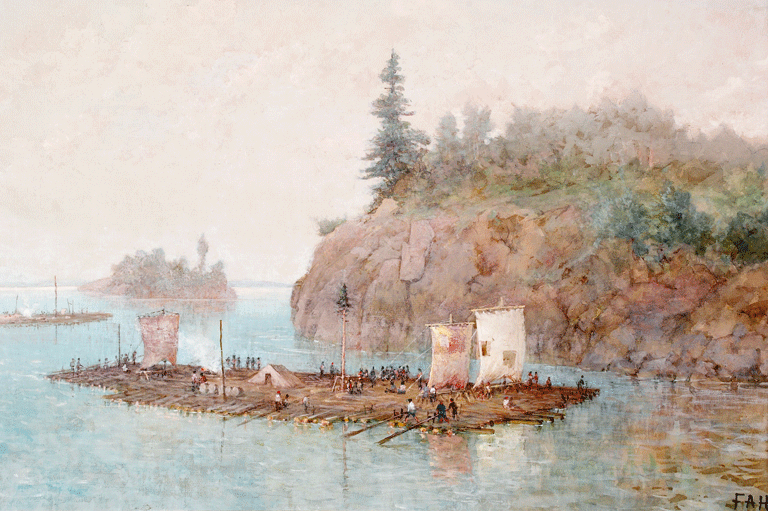Algonquin Territory
The traditional territory of the Algonquin people has always included the Ottawa Valley and adjacent lands, straddling the border between what is now Quebec and Ontario. Unlike most of Ontario and the Prairies, Algonquin territory has never been dealt with by a land-sharing Treaty. Algonquin title continues to exist.

Algonquin Nation Territory circa 1850–1867. This map is provisional. Boundaries are based on results of research to date and may change as discovered (Algonquin Nation Secretariat, 2018.)
The orange line shows portions of the boundary covered by the Royal Proclamation of 1763, issued by King George III following the end of the Seven Years War. The Proclamation contains important provisions regarding First Nations’ rights to their traditional territories.
With the arrival of the Europeans, the ancestors of today’s Algonquins were already well-established in the Ottawa Valley. Initially, the people who now identify as Algonquins were known by a variety of names. The Jesuit priest Pierre François Xavier de Charlevoix, in his 1744 Journal of a Voyage to North America, mentions the Algonquins, Nipissings, Timiskamings, Têtes-de-Boules, and Gens des Terres.
By the end of the nineteenth century, “Algonquin” had become regularized to refer to those peoples occupying the Ottawa River watershed whose neighbours were the Mohawks (to the east), the Atikamekw and Cree (to the northeast and the north), and the Anishinaabe (to the west and the south).
At present there are ten recognized Algonquin First Nations with a total population of around eleven thousand. Nine of these communities are in Quebec: Kitigan Zibi, Barriere Lake, Kitcisakik, Lac Simon, Abitibiwinni, Long Point, Timiskaming, Kebaowek, and Wolf Lake. Pikwakanagan is in Ontario.
Three other First Nations in Ontario are at least partly of Algonquin descent, connected by kinship: Temagami, Wahgoshig, and Matachewan.
Before the coming of the railways, water routes were the primary communication and transportation corridors. The Ottawa River was the highway that connected the St. Lawrence to the Upper Great Lakes and the northern interior.
The Jesuit Relations of 1636 notes that the Algonquins and Nipissings controlled this strategic route: “The Hurons and the French now staying in the Huron country, wishing to come down here, pass first through the lands of the Nipisiriens [Nipissings] and they come alongside this [Allumette] Island, the inhabitants of which cause them every year some trouble, by demanding toll from all the canoes of the Hurons, Ottawas and French.”
As Gilles Havard documents in The Great Peace of Montreal of 1701: French-Native Diplomacy in the Seventeenth Century, the French benefitted commercially and militarily from the access to the upper country that their alliance with the Algonquins and Nipissings guaranteed.
But, as can be seen from surviving Hudson’s Bay Company account books (for instance, the books from Fort Albany in 1695), the Algonquins also traded with the English at James Bay, depending on where they could get the best deals.
Partly in acknowledgement of the balance of power, and partly from expediency, both the English and the French employed First Nation practices and protocols in their political, trade, and military relations with the Algonquins and other nations, including the use of presents, the exchange of wampum, and Treaty making.

With 7 uniquely curated newsletters to choose from, we have something for everyone.
For instance, in July 1759, Sir William Johnson, who managed Indigenous relations for the British, held a council with the Chippeway (Anishinaabe) and addressed Tequakareigh, one of their chiefs:
“With a string and two belts of wampum, I bid him welcome and shook him by the hand. By the 2d, which was a black belt, I took the hatchet out of the hands of his, and all the surrounding nations; recommended hunting and trade to them, which would be more for their interest than quarrelling with the English.”
At this point in the Seven Years War, when the French- English competition for control of northern North America entered its final phase, the British worked hard to obtain the neutrality, if not the outright alliance, of the First Nations allies of the French. These included the Algonquins, not least because they controlled the water routes that provided access to Montreal and Quebec.
Late in August 1760, Johnson entered into a Treaty with nine First Nations at Swegatchy (Oswegatchie) near what is now Ogdensburg, New York, “whereby they agreed to remain neuter on condition that we for the future treated them as friends, & forgot our former enmity.”
According to the First Nations parties, the Treaty of Swegatchy included the guarantee that the British “would secure to us the quiet & peaceable Possession of the Lands we lived upon.” For the British, this Treaty opened the road to Montreal.
Article 40 of the Articles of Capitulation of Montreal, drafted by French Governor Pierre de Rigaud de Vaudreuil and accepted by the English on September 8, 1760, provided that France’s former First Nations allies would be “maintained in the lands they inhabit; if they chose to remain there; they shall not be molested on any pretence whatsoever.”
The British also entered into a Treaty directly with the First Nations at Kahnawake on September 15 to 16, 1760, which confirmed the terms of the peace. In the following months, British officials regularly assured the former allies of the French that their land rights would not be prejudiced.
For instance, on July 11, 1761, General Jeffrey Amherst wrote to Johnson: “The Indians may be Assured I will protect them in their Lands; Whether they dispose of them or not, is entirely at their own option, I shall never force them to dispose of any, but will Secure them in what they have; and no otherwise Interfere with their Lands, than by taking such Posts as I may think necessary, for ensuring the protection of this Country for the King.”
Unfortunately, in many cases these promises were not kept, leading to continued friction, including an inter-tribal uprising against the English, led by Pontiac, an Odawa war chief.
King George III’s Royal Proclamation of 1763 was partly intended to provide additional assurances to First Nations that “frauds and abuses” and land grabbing by settlers would be stopped. It recognized the pre-existing land rights of the First Nations and established principles for a formal Treaty-making process, whereby First Nations lands could only be taken up by way of consent and fair compensation.

The Algonquins were a part of these events. They were at the Treaties of Swegatchy and Kahnawake and received copies of the Royal Proclamation.
There are also wampum belts held by the Algonquins that come from this period and that record these events and the commitments made therein. These belts were presented to the prime minister and premiers of Canada during the March 1987 first minister’s conference in Ottawa.
At that time, Chief Solomon Matchewan, his son Jean-Maurice, and a delegation of Algonquins explained the belts, including the Three Figure Covenant: “The representative of the French-speaking nation on one side and the representative of the English-speaking nation on the other side, and on the centre is the Indian nations. And it was agreed at this time that the Indian nations would always be leaders in their homelands. And anything that was supposed to be negotiated upon, that they would have to negotiate with the Indian people …. This Covenant was confirmed by the Articles of Capitulation of 1760 and the Royal Proclamation of 1763. It is significant that this meeting is taking place on Algonquin land. Our people never surrendered these lands; nevertheless we are being pressured to remain on reserves. This is not what our ancestors intended. This covenant, which was made with the English and French Nations, that is contained in the wampum belt may have faded from your memories, but it has not yet faded from ours.”
Between 1766 and 1861 a series of royal instructions, ordinances, and new laws confirmed and reflected the assurances that had been made by the British with respect to the protection of First Nations lands, including protections against trespass.
One example is a proclamation by Guy Carleton, governor of Quebec, dated December 22, 1766: “The Lieutenant Governor and Council of this province do hereby strictly enjoin and command all the Inhabitants ... to avoid every occasion of giving the Indians offence, and to treat them as Friends & Brothers entitled to His Majesty’s Royal protection, & if any of the said Inhabitants have made any settlements on the Indians grounds, to abandon them without delay, under pain in case of Failure herein, of being prosecuted as Disturbers of the peace of the province with the utmost rigour of the law.”
However, for a variety of reasons, the assurances regarding the protection of First Nations lands and the need to enter into Treaty before settlement — assurances the British provided from 1760 onward — were not applied to the Algonquins or their territory.
Pressure for land increased in the period following the end of the American Revolution in 1783, when British Loyalists came north to Canada and had to be resettled. The Algonquins became alarmed and began to petition government, requesting that their lands be protected and that if settlement was to occur Treaties should be made.

At a council between the Nipissings, the Algonquins, and Colonel John Campbell, held on July 14, 1794, the chiefs complained that pressure from settlers was forcing other tribes onto their hunting grounds, so “we cannot provide for our families, we starve during the winter, and thus we cannot pay our debts.”
They also asked that no further lands be taken up by settlers and for one settler in particular to be sent away:
“There is one person among them named Captain Fortune who causes great problems for us. He prevents us from setting nets in the river, saying that the fish belong to him and he even forbids us from shooting partridge, claiming they belong to him alone. He forbids us from taking wood to boil our water and goes so far as to throw down our lodges and stop us from camping. We ask you to be so good as to send him away because it could result in one of our young men having some bad business with him. Moreover, the Master of Life has given us the woods and the shore from which to take as much as is appropriate.”
This was followed by a long series of petitions and requests to various imperial and local government officials in the following decades. One of the Algonquin petitions, from the fall of 1824, was given to Sir John Johnson, superintendent general of Indian Affairs and the son of Sir William Johnson.
The chiefs gave John Johnson the original copy of the Royal Proclamation of 1763 that had been given to them sixty years earlier by his father. At the bottom of the proclamation, he wrote, “At the earnest request of the Algonkins I put my name to this. John Johnson. God Save the King.”
Their alarm only increased as the lumber industry moved up the Ottawa River and its tributaries in the first decades of the nineteenth century.
On June 29, 1835, James Hughes, superintendent of the Indian Department, forwarded a petition from the Algonquins and Nipissings that laid out their case:
“They represent their hunting Grounds, to be entirely ruined by the White Settlers to whom they have been conceded, the squatters that have taken possession of certain portions but more particularly by the lumber men, who generally set fire to the woods which destroys their Beaver and Peltries and drives away the Deer. Necessity obliges them to make known their Grievances.”
p.p1 {margin: 0.0px 0.0px 0.0px 0.0px; text-align: justify; line-height: 14.1px; font: 14.0px 'Adobe Garamond Pro'; color: #8a53a8}
Today, 258 years after the Treaties of Swegatchy and Kahnawake, and 255 years after the Royal Proclamation of 1763, Algonquin Indigenous title — including to Ottawa, the nation’s capital — remains an outstanding issue.
Ironically, the only land Treaty affecting Algonquin territory was made not with the Algonquins but with the Mississaugas, for lands north of what is now Kingston, Ontario, and up to the Ottawa River — a fact that was bitterly noted by the Chiefs:
“That Your Petitioners have recently heard with surprise that the Mississauga Tribe have sold to the Government of Upper Canada a certain portion of our said Hunting Grounds and that they receive an annuity for the same amounting to £642 10s per annum without our knowledge, consent or participation in any shape or manner whatever, wherefore Your Petitioners claim from Your Excellency justice; that the said sale by the Mississaugas be cancelled and annulled and the said annuity paid to your Petitioners.”
Despite their protests, no land Treaties were made directly with the Algonquins and they never received any compensation for their lands. The timber was too valuable and the imperial government was not prepared to struggle against powerful settler interests at a time when it was looking to off-load its responsibilities and have the colonies pay their own way.
At the time of Confederation, the government of Quebec simply refused to consider the notion of Treaty, and for its part the government of Ontario was hostile to any recognition of Algonquin interests on the south side of the Ottawa River.
This hostility even extended to the setting aside of reserve lands for the Algonquins. The people at Golden Lake (Pikwakanagan) were forced to purchase their own lands in 1873.
Lands were reluctantly set aside by Quebec at River Desert and Timiskaming in 1851 and at Lac Simon and Rapid Lake in 1961–62. The Algonquins of Abitibiwinni used their own funds to purchase their reserve at Amos in 1956; and Canada purchased a small reserve for Kebaowek in 1974.
Today three Algonquin communities (Wolf Lake, Kitcisakik, and Long Point) still do not have reserve lands of their own. With regard to his community, Chief Harry St. Denis of Wolf Lake says, “The Wolf Lake First Nation is one of the oldest recognized Algonquin First Nations but still remains without a land base, which puts us at a severe disadvantage when providing programs and services to our members. This is an injustice we hope to settle soon either through negotiations, the Specific Claims Tribunal, or the courts.”
So today, 258 years after the Treaties of Swegatchy and Kahnawake, and 255 years after the Royal Proclamation of 1763, Algonquin Indigenous title — including to Ottawa, the nation’s capital — remains an outstanding issue.
Register to receive your FREE educational package devoted to Treaties and the Treaty Relationship.
Packages are aimed at Grades 2–7 and Grades 7–12, and available in both English and French.
Themes associated with this article
Advertisement
More from the Treaties issue
These articles, as well as the corresponding educational resource package, can be found on the French side of our site.

Encouraging a deeper knowledge of history and Indigenous Peoples in Canada.
The Government of Canada creates opportunities to explore and share Canadian history.

The Winnipeg Foundation — supporting our shared truth and reconciliation journey.













